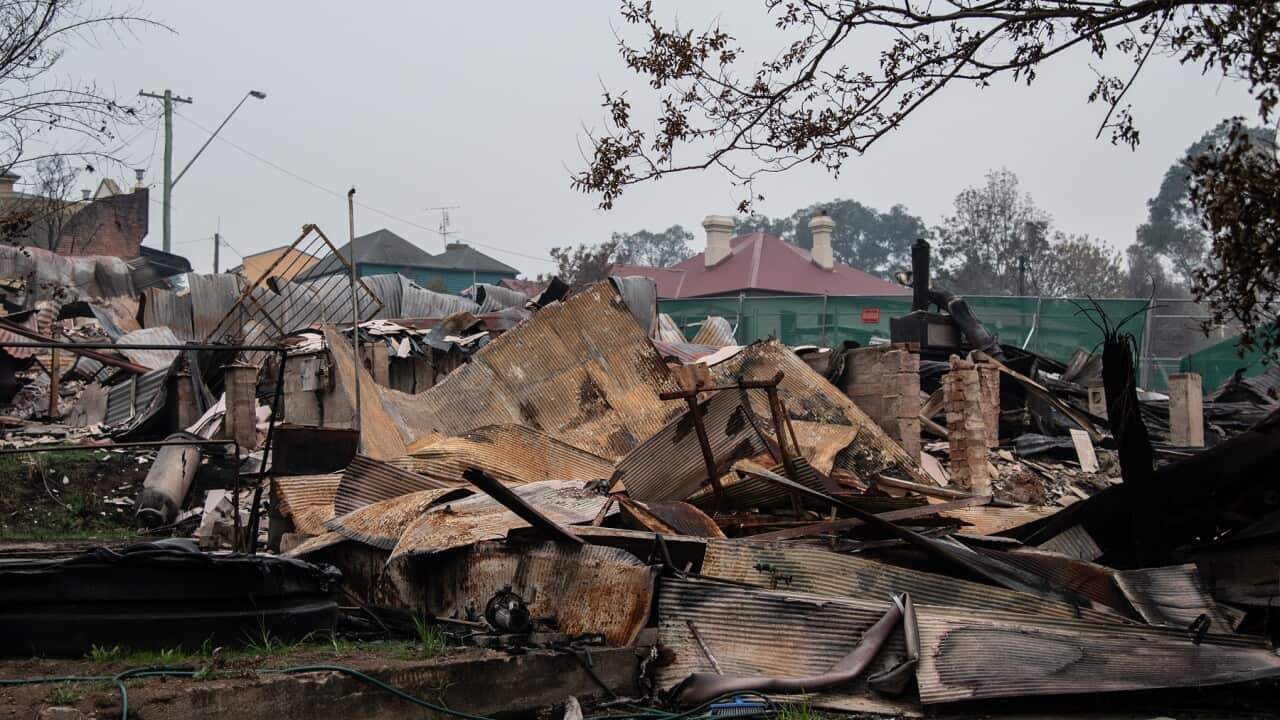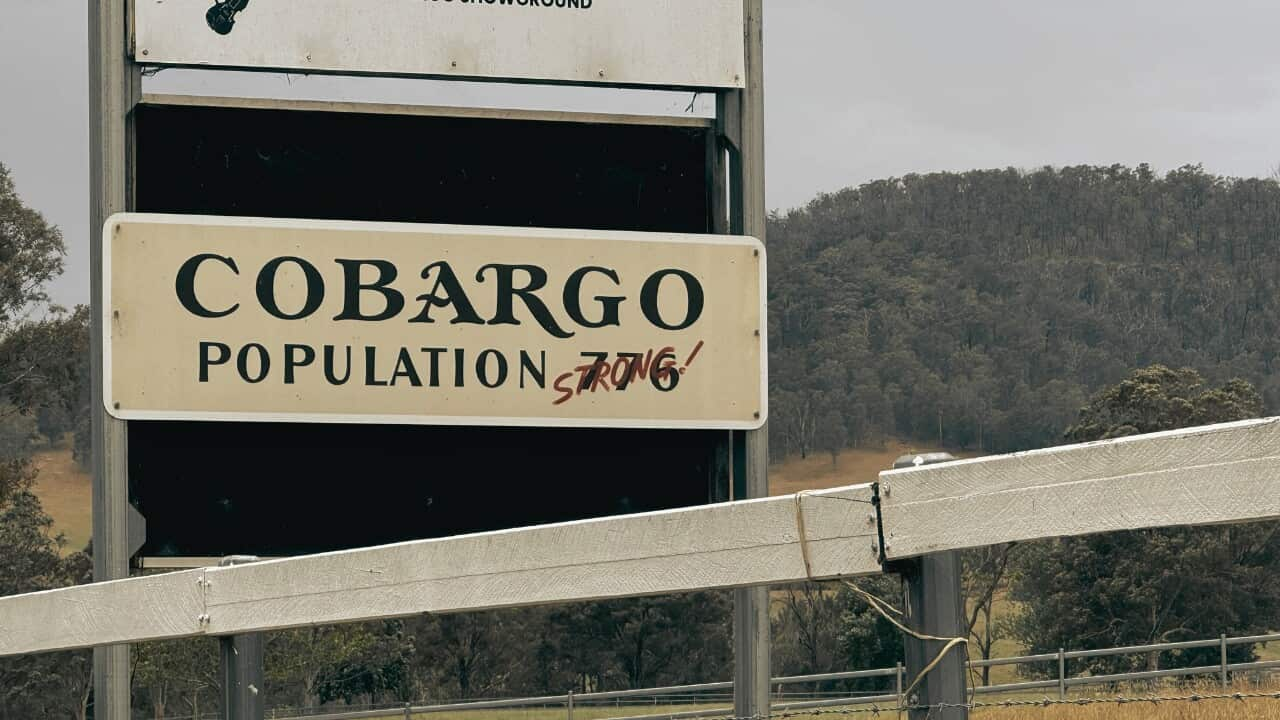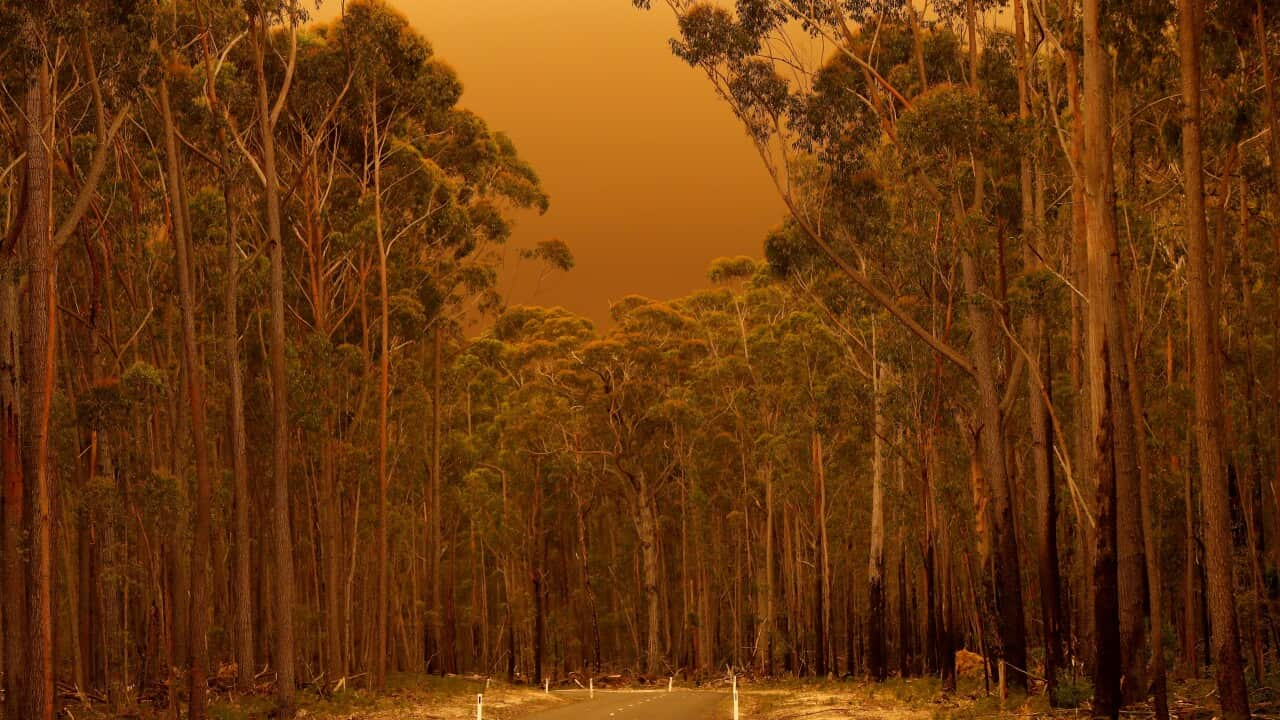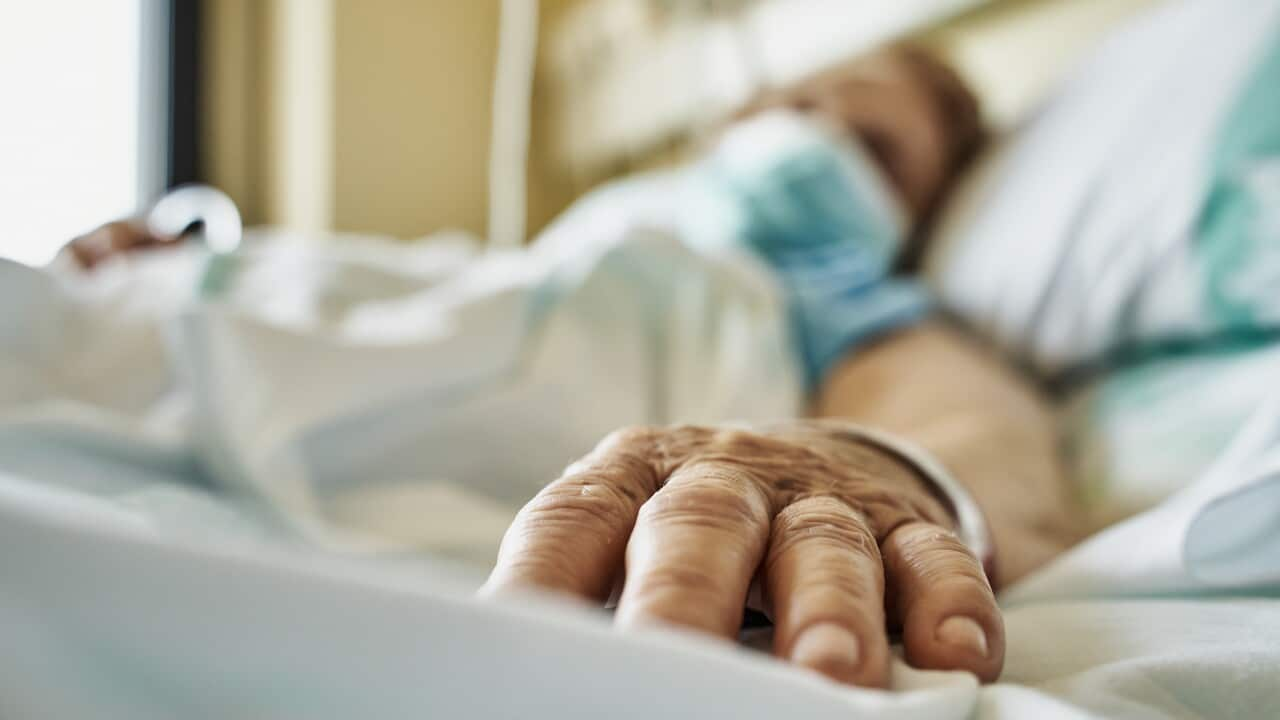TRANSCRIPT
“We have to think differently about the country. If you think that that tree is one of your ancestors, then you care for the tree. If you think that the river is a living organism, you don't pump your shit into it. You treat the country differently and respectfully. And if we did that, if that was in our psyche, there'd be stuff we would do automatically, almost unconsciously, which would help us save the planet. Fire is just one of the things that is going to be a huge problem for us in the future.”
It's been five years since the Black Summer bushfires burnt throughout Australia.
The enormity of them made headlines worldwide, and despite the scale of devastation they caused to communities in regional areas, those hardest hit think the Australian government will let it happen again.
The fires that year have been pretty consistently described as unprecedented, with scientists since confirming they were anything but normal.
So as Australia's fire seasons get longer and longer, how prepared are we for the next time fire comes?
“All the studies, no one ever has seen a fire like this before. The behavior of the fire was totally different from anything anyone had ever seen before. So that, as I say, they were prepared for a fire, but not for a fire of that type. And in terms of preparation for the future, I think that people are really, really, really well prepared now.”
For Chris Walters in Cobargo, it's difficult to prepare for something so unpredictable.
When she says people are really well prepared now, she's not talking about the country as a whole, she's talking about the people in Cobargo, the people who lost their homes and their main street and members of their community.
The people in the places that were hit by those fires, like the people in Cobargo and Mallacoota, say most summers bring back some anxiety.
“There's anxiety about the next fire season, the next weather event, the next, of course there is. And that's probably worse when you've had one event in your recent past than it is if you haven't. So it's a bit complicated. The journey from recovering into becoming more resilient is a really tricky one. It's really complex and you have to understand your own recovery journey in order to be able to go on embark on a resilience or preparedness journey, because that's actually a really difficult thing to think about when you're in a recovering mindset and a recovering conversation and a recovering community, you can feel really reluctant to talk about preparedness and what about the next event? And so the big buzzword now is resilience. And I kind of think that in a recovering community, it takes us a while to be ready for that conversation. And yet in a not recovering community or community that hasn't been impacted, I think people are pretty relaxed about having that conversation if they could even be bothered.”
Australia has experienced eight of its nine hottest years on record in the last 11 years.
While 2024 has now been named the hottest year on global records, 2019 still holds the record for the hottest and driest year in Australia.
For Jann Gilbert, a marine biologist and member of Bushfire Survivors for Climate Action, there are still so many things the government need to do if they're going to soften the blow of future disasters.
“Do something about getting emissions down? Emissions are still rising. I mean, you can't, on one hand, the labor government says, oh yes, renewables and blah, blah. Well, that doesn't bring emissions down. And we're still exporting emissions to the rest of the world. And scope three emissions have to be counted. That's one thing we have to do in our supposed nature positive laws, which are a piece of crap. But no, there's no climate trigger for projects. There's no end to fossil fuel, new or expanded fossil fuel projects. That's what we need to be having the national conversation about how we do this really quickly, because if we don't, by 2030, we've already got at least 20 years of climate disasters locked into the system. So the longer we continue to allow emissions to increase, the longer we will have those disasters locked into the future.”
It's reported that the Black Summer bushfires released about 900 million tonnes of carbon dioxide into the atmosphere; that's approximately the same as the annual emissions released by commercial air travel worldwide.
Losing her house and witnessing the environmental destruction in Mallacoota wasn't what made Jann realise how serious climate change was, but it did give her a unique understanding of how bad things were already getting.
“Particularly when I got my science degree then, but I'd worked in Seabird rescue and Marine turtle rescue before that, which is what led me to do the science degree. So I knew about all of those sorts of things about warming oceans. I mean, as soon as I read the 2006 IPCC report, I mean, even before that I was on board anyway, but that 2006 IPCC report was the absolute now, I mean, I can't understand how anyone could deny, and they were actually taken to task with that one because everyone went, oh know, catastrophe modeling, and actually they were really conservative models and all of them, and that report predicted that around about 2018 to 24 is when we'd start seeing really catastrophic effects and guess what happened.”
As well as the 33 people directly killed in the fires, and the estimated 445 people killed by smoke inhalation, around three billion animals and 60 billion invertebrates died that Summer.
“I mean, harder than my house and everything else was the environmental destruction for the first two weeks here. Thankfully we got some, I can't remember. There's a vet organization that actually comes into climate disaster places or places where disasters have happened and euthanises the animals that need to be euthanised. So all you heard for the first two weeks was shotguns.”
More than 25 per cent of the people who were directly impacted that summer, either through fighting the fires or living in the affected areas, reported symptoms of trauma and psychological distress.
Once the fires passed through though, trauma continued to affect those dealing with the aftermath.
In studies carried after the bushfires, a lot of veterinary and wildlife workers also reported symptoms of psychological distress, as they were forced to euthanize and count the scores of animals that couldn't escape in time.
“First two weeks, the whole beach was just covered in ash and thousands of dead birds, thousands of them who'd all come out of the forest trying to escape the smoke and just literally dropped out the sky because birds have air sacks in their wings as well. So they don't only breathe in through. So they just got suffocated and there were literally thousands of them. I think Bushy Bob, who's a very well-known naturalist here. He did the whole walk. None of the rest of us could do it. And I think he counted 150 species.”
In Cobargo, the fires made people acutely aware of just how fragile their energy supplies were.
In the aftermath of the bushfires, which burnt through the main street and destroyed infrastructure like power lines, some members of the community decided they needed a back up plan.
Debra Summer is a committee member of a group called Renewable Cobargo, formed after the fires to improve energy security and energy efficiency in the Cobargo region.
“We initially focused on the concept of having a microgrid solar farm with backup battery that was islandable. So if there was another bush fire or floods or big winds, any weather event, heat, whatever, and power went down, it's a very vulnerable electricity energy system through here. In the fires, over 2000 poles had to be replaced. And we are on the tippy end of the energy grid as well. Very fragile part of it. So we thought during the bushfires we had no water, no power, no communications. It was really bad. So at least we need to look at how we can keep the town powered, even if it's not the whole one, the bulk of it. Things like the co-op, the petrol station, the doctors, the chemist, cool spaces for people to be able to be in heat stress and whatever.”
She says that while many people became interested in climate change after the fires, it was really important to communicate with people about what exactly the changes could do to benefit them.
“It's a complex area as you'd know, and there's still a lot of misinformation out there stuff, and which is why community engagement is critically important and doing it well and well designed so that everyone can get heard and have a voice, but it's not taken over with misinformation. And I guess we also put a focus on when we had that coming up against us, particularly with the microgrid Solar Farm stuff, about looking at how we approach community and what we are looking at doing by providing, I guess a solutions based approach where it becomes clear of the benefits for everyone, regardless of whether you believe in climate change or clean energy or whatever, that if this happens, the power stays on, you get this, or you might get lower energy bills or whatever.”
Bruce Pascoe is a Yuin, Bunurong and Tasmanian historian and author living on Yuin Country, not far from Mallacoota.
“Mallacoota is not the same town that it was. Mallacoota has always been such a laid back bandit kind of town. A lot of fishing towns are full of renegades and yahoos, which makes it very appealing place. But it's changed quite a lot. There's still a bit of that of course, but it's changed quite a lot. And when those northerlies start, you'll see the change in people. That whole town gets a lot nervier”
Bruce says ever since the fires came through that summer, the psyche of the town changed.
With such a catastrophe in recent memory, he says the community is always looking out for signs of another.
“I think it's so dry now that rain is so pissy that it's not going to help. And looking into the future, up until Christmas, I can't see any more rain. So by Christmas it's going to be really, really dangerous. And we had a big wind the other day, but it wasn't true north; wasn't our hottest wind. But once we get one of those hot dry northerlies with all the other conditions, they'll be say in three or four weeks time it'll go like that. It could be worse than last time because people were saying, oh, you'll never have another fire like that. Yeah, we will.”
In Cobargo, where the main street is still under construction, Chris Walters says the level of alert is pretty similar.
“Oh yes, absolutely. Yeah. Yeah. Like a day today, it's really hot and it's windy, and the first thing you think of is, oh dear, could be a bad day today. And look, those thoughts were probably in people's minds before the black summer bush fires, but they're very heightened now, and it doesn't take very much to trigger people at all. Just the smell of smoke and people are triggered. Yeah, they're very, very aware of it.”
When you drive through the forests and bushland lining the east coast of Australia, where the bushfires tore through that summer, you can still see where the fires tore through.
While they're full of regrowth and vibrant greenery, most of the trees are still blackened at the base.
One of the common ways authorities prepare these areas for bushfire season is through controlled burns, but since that summer, some places have avoided it, with fears it could get out of hand.
“Oh, fuel loads are very high because after 2019, nobody, the parks and that are very risk averse. So no one was doing controlled burns. We do controlled burns here, so our property is always under control. But the bush in that you drove through, that's all post 2019 fire regrowth and it should have been burnt. Burnt, not incinerated, just a cool slow burn through there would've made it a lot safer. Now we've got this match factory that we're going to drive through every time to get off the property.”
One of the things Bruce says helped his property that year was using Indigenous land management practices.
“These dozen or so big trees down here didn't burn in the fire. People say, oh, you didn't have the fire here. I said, yeah, I did. They said, well, they're not burnt. I said, because they're spaced so far apart that they couldn't burn. And they're such old trees that their first branch is way up high. When you get small trees like these wattles here, look how low their first branch is. That grass catches alight, the tree catches alight, and wattles are very volatile. Whereas these eucalypts, all the bottom of the trunks are all burnt, but they survive the fire and they didn't spread the fire. Big trees don't spread fire unless it gets up into the crown. And so we've got to do everything we can to keep the fire out of the crown of the tree, because then it's just like a torch, one torch touching onto another torch and the whole thing goes.”
Before colonisation, for more than 50,000 years, First Nations communities had their own methods of caring for country, one of which was a type of controlled burn.
Bruce says those practices were integral in keeping the land and community sustained and safe.
“Yeah. The old people worked really hard. There was a continual effort to make the bush safe and they worked on it. They would've worked on it all through autumn, all through winter. And in order to do this again, we need a lot of people and a lot of time, and not just one year here and one year there, you have to look at a span of 30 or 40 years so that in that 30 or 40 years, you burnt this bit here, you burnt that bit there, and then you come back to the one you burnt three, four years ago. And gradually you'll get the country back to the way the old people had it. And we see examples of that bush still around, but it's rare. But we know what we are aiming for. “
Not everyone in Mallacoota agrees that controlled burns are the way to go, some people say they should just leave the forest alone, that humans have interfered too much already.
But Bruce says, if done right, it isn't about torching the forest or messing with the ecosystems, it's about safety.
He says if done correctly, in small areas, burnt slowly, at the right time of year, it should be cool enough you can walk through in shorts and a pair of thongs.
He shows us a patch of grass on his property, with a barrier about a metre deep cut around it, an area he's preparing for a cool burn when the rain stops.
“Oh, it's about safety. Yeah. Well, if we're at all concerned, what we'll do is like we've done here, we're prepared a pretty wobbly square, but we've slashed. So if we were to burn that, I'd race around with that tanker and just spray a line that wide on the cut grass. And if I'm doing the fire properly, it'll go out as soon as it reaches that moisture. It's just another safety barrier. And I'd only do that for the sake of my neighbors. So keep them from panicking. Other people are shit scared of fire because when they light a fire, it roars. These just trickle around.”
Fire, Bruce says, doesn't have to be a scary thing.
“We turn 'em into a picnic because we often have kids with us. There's a lot of standing around and walking beside the fire. No one should be panicking. I don't want to see anyone running. If you're running, you're not prepared. So we just cruise around. My son is a very good firefighter too. And when we do a fire, his little 5-year-old daughter comes with us and she can walk right up to the edge of the fire because it's so gentle and she's so used to it that she's not scared.”
Jann Gilbert says there are some people in the community who would rather see the whole forest taken out, removing the threat altogether and creating a barrier around the community.
“There are still a small group of people here who would like to just raze the whole Croajingolong National Park to make themselves feel safer and still using totally useless - in inverted commas - management regimes. Yeah. Our whole emergency services, we need emergency services personnel before we need politicians, actually, Because they're far more useful, but particularly in Victoria since they separated the CFA and Fire Rescue Victoria now. So that made all CFA people who work for CFA, unless they were in management. It made them all volunteers. And all of those volunteers are now my age, and it's really hard to get young people in because often they don't have the time. They're working two or three jobs.”
There were around 65,000 volunteers fighting the fires that year, but cost of living pressures mean less and less people may have the means or time to step up to the job next time around.
And with a lack of stable employment in the fire services, dealing with trauma in the aftermath wasn't always easy for people who had to return back to their normal lives.
Nearly 11 per cent of responders in Black Summer have been diagnosed with P-T-S-D.
And in the year following the fires, studies showed that 5.5 per cent of the responders made suicide plans.
Carol Hopkins says that ahead of the next disaster, communities would benefit from people working as caseworkers and other jobs that rely on emergency funding, to be given more secure employment.
“If we had people who worked in these roles on a more permanent basis that were spread across the country and had proper careers where they were able to stay in those roles in the longer term. I think even though geographically, yes, it's a very wide spread, I think that there needs to be maybe a more solid combination of permanent roles and roles in response that arise in response to something. And again, I guess that's a federal funding issue because organizations like RFDS and Red Cross and all the others receive their funding in those great big chunks that pour in after a disaster and then dry up and they're gone. And so they can't keep staff. They can't offer contracts that are more than the length of the period of time of the funding that they have. So I think that that's something that really needs a way bigger picture view.”
Beyond the human and environmental losses caused by bushfires, there are also major economic losses.
The Treasury estimates that the economic impact of the Black Summer bushfires was a $4.6 billion reduction in G-D-P.
The Insurance Council of Australia said the total insured damage from the event totalled $2.32 billion, with almost 40,000 claims lodged.
As the frequency and severity of natural disasters in Australia increase, the costs will too.
Currently, 97 per cent of disaster spending comes after the disaster, with just three per cent spent on preparation.
For Jann, it isn't that the government lacks the knowledge or resources to make things better, she says they're out of touch with what people need.
“ We seem to have all the money in the world to be able to pay politicians and give them pay rises and all those sorts of things, but we've never got enough money to keep communities safe by having state-of-the-art, proper fire management, and that includes involving Aboriginal people, getting CSIRO involved. But the thing that bothers me so much about governments is that they're denying the science. They're not listening to the science. They're not following the science. They're cherry picking bits that suit them, and they're multi-billion dollar donors, but they're not actually doing anything to keep people in communities and particularly remote communities safe. I've refused to pay my fire service levy in my rates. I don't get a fire service here.”
Research from Monash University predicts that in the decade to 2030, more than 2,400 lives will be lost to bushfires in Australia.
With decades of rising temperatures and changing climate already locked in, there's no shortage of voices offering ways to reduce the risks.
Bruce Pascoe says, if managing the forest and making it safer takes decades, there's no better time to start that right now.
“Get out in the bush, there should be no unemployment in this country. Aboriginal communities should be engaged. And so that we've got teams of young people and as many Aboriginal people as we can possibly get to working in the forest. There should be teams of young people working right through autumn and winter at managing the forest. And it'd take decades to get to where you wanted to be. But if we committed to that, instead of what we do is we put those people in the forest in the wrong season. In the summer when all they're doing is trying to stop fires, and a lot of those fires will be so hot, no one's going to be able to stop them. And that's when people get killed and property is lost.”
Almost everyone SBS spoke to for this series said a similar thing, the people in charge should be listening to the people who went through it.
When the fires happened that year, everyone can acknowledge that it was almost impossible to prepare, no one could have possibly predicted how intense they would become.
But while preparing for things we know are going to just get worse and worse seems an insurmountable task, listening to the people who are preparing, and who took it into their own hands to pick themselves back up, might just be the best bet we have.
“ Every day, changes you if you allow yourself the opportunity to learn? No matter how one may think they have it down pat, regardless of how complex one's thoughts or mind is, it is still limited by certain structures of imprisonment of itself. So therefore you know what? But you know that because that's all, there has to be a point where you accept outside the input to then offer yourself that chance to grow, be a better person.”











